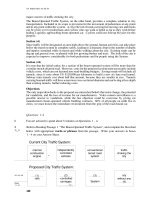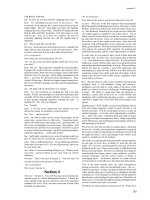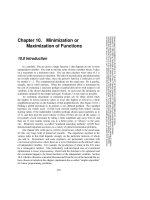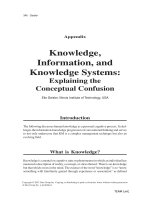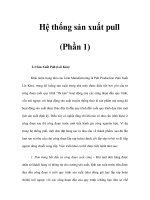Tài liệu Knowledge-Based Enterprise: Theories and Fundamentals Part 1 pptx
Bạn đang xem bản rút gọn của tài liệu. Xem và tải ngay bản đầy đủ của tài liệu tại đây (1.7 MB, 80 trang )
TEAM LinG
i
Knowledge-Based
Enterprise:
Theories and
Fundamentals
Nilmini Wickramasinghe
Illinois Institute of Technology, USA
Coventry University, UK
Dag von Lubitz
Med-SMART, USA & Central Michigan University, USA
Hershey • London • Melbourne • Singapore
IdEa Group puBlIshInG
TEAM LinG
ii
Acquisitions Editor: Krisitn Klinger
Development Editor: Kristin Roth
Senior Managing Editor: Jennifer Neidig
Managing Editor: Sara Reed
Assistant Managing Editor: Sharon Berger
Copy Editor: Larissa Vinci
Typesetter: Amanda Appicello
Cover Design: Lisa Tosheff
Printed at: Integrated Book Technology
Published in the United States of America by
Idea Group Publishing (an imprint of Idea Group Inc.)
701 E. Chocolate Avenue, Suite 200
Hershey PA 17033-1240
Tel: 717-533-8845
Fax: 717-533-8661
E-mail:
Web site:
and in the United Kingdom by
Idea Group Publishing (an imprint of Idea Group Inc.)
3 Henrietta Street
Covent Garden
London WC2E 8LU
Tel: 44 20 7240 0856
Fax: 44 20 7379 0609
Web site:
Copyright © 2007 by Idea Group Inc. All rights reserved. No part of this book may be reproduced, stored or
distributed in any form or by any means, electronic or mechanical, including photocopying, without written
permission from the publisher.
Product or company names used in this book are for identication purposes only. Inclusion of the names of the
products or companies does not indicate a claim of ownership by IGI of the trademark or registered trademark.
Library of Congress Cataloging-in-Publication Data
Wickramasinghe, Nilmini.
Knowledge-based enterprise : theories and fundamentals / Nilmini Wickramasinghe and Dag von Lubitz,
authors.
p. cm.
Summary: “This book provides comprehensive coverage of all areas (people, process, and technology) neces-
sary to become a knowledge-based enterprise. It presents several frameworks facilitating the implementation of
a KM initiative and its ongoing management so that pertinent knowledge and information are always available
to the decision maker, and so the organization may always enjoy a sustainable competitive advantage”--Pro-
vided by publisher.
Includes bibliographical references and index.
ISBN 1-59904-237-1 (hbk.) -- ISBN 1-59904-238-X (softcover) -- ISBN 1-59904-239-8 (ebook)
1. Knowledge management. I. Von Lubitz, Dag K. J. E. II. Title.
HD30.2.W523 2007
658.4’038--dc22
2006033748
British Cataloguing in Publication Data
A Cataloguing in Publication record for this book is available from the British Library.
All work contributed to this book is new, previously-unpublished material. The views expressed in this book are
those of the authors, but not necessarily of the publisher.
TEAM LinG
iii
dedication
For our mothers
TEAM LinG
iv
Knowledge-Based
Enterprise:
Theories and Fundamentals
Table of Contents
Foreword.........................................................................................................viii
Michael J. Ginzberg, University of Delaware, USA
Preface............................................................................................................... xi
Section.I:.Understanding.Knowledge
Chapter.I
Overview.of.the.Networked.Knowledge.Economy........................................ 1
Introduction .............................................................................................. 1
What is the Knowledge Economy? ........................................................... 2
Managing in the Knowledge Economy with Knowledge
Management ........................................................................................ 5
KM Drivers .............................................................................................. 7
How to Become a Knowledge-Based Enterprise ....................................11
Chapter Summary .................................................................................. 13
Chapter.II
Understanding.the.Knowledge.Construct.................................................... 16
Introduction ............................................................................................ 16
Historical Understanding of Knowledge ............................................... 17
Data, Information, and Knowledge ........................................................ 18
Types of Knowledge ................................................................................ 23
The Organizational Knowledge Life Cycle ............................................ 30
Why is Knowledge Valuable ................................................................... 34
Chapter Summary .................................................................................. 37
TEAM LinG
v
Chapter.III
Creating.Organizational.Knowledge............................................................. 42
Introduction ............................................................................................ 42
The Socio-Technical Perspective for KM ............................................... 43
Duality and the Knowledge Construct ................................................... 45
Frameworks for Knowledge Creation .................................................... 47
A Socio-Algorithmic Approach to Knowledge Creation ........................ 55
Chapter Summary .................................................................................. 60
Section.II:.Infrastructures.Required.to.Support.
Knowledge-Based.Enterprises
Chapter.IV
The.KM.Business.Infrastructure................................................................... 65
Introduction ............................................................................................ 65
Systems Thinking .................................................................................... 66
Historical Development of Information Processing ............................... 68
Business Process Re-Engineering (BPR) ............................................... 69
Total Quality Management (TQM) ......................................................... 71
Enterprise Resource Planning Systems, Supply Chain Management,
and Customer Relationship Management ......................................... 75
Enterprise Integration ............................................................................ 84
Chapter Summary .................................................................................. 91
Chapter.V
The.Organization’s.Human.Infrastructure.................................................. 96
Introduction ............................................................................................ 96
Knowledge Workers................................................................................ 97
Capturing Knowledge from Knowledge Workers ................................... 98
Organizational Considerations ............................................................ 105
Change Management ........................................................................... 106
Organizational Culture and Structure .................................................. 107
Management and Leadership ................................................................116
Chapter Summary ................................................................................ 124
Chapter.VI
The.KM.Technological.Infrastructure........................................................ 129
Introduction .......................................................................................... 129
Knowledge Architecture ....................................................................... 130
Establishing a Knowledge Management Infrastructure ....................... 133
Knowledge Management Infrastructure Design .................................. 136
Knowledge Management Tools and Techniques .................................. 141
Chapter Summary ................................................................................ 161
TEAM LinG
vi
Section.III:.Becoming.a.Knowledge-Based.Enterprise
Chapter.VII
KM.and.Strategy........................................................................................... 166
Introduction .......................................................................................... 166
Generic Structures ................................................................................ 166
Industry Analysis .................................................................................. 168
Internal Analysis Porter’s Value Chain Model .................................... 170
The Reverse Value Chain ..................................................................... 171
McFarlan’s Strategic Grid ................................................................... 173
Designing a KM Strategy ..................................................................... 174
Competitive Advantage and Value Creation ........................................ 178
Incorporating KM into the Strategic Vision ......................................... 180
Chapter Summary ................................................................................ 183
Chapter.VIII
Managing.Knowledge.Complexity.............................................................. 187
Introduction .......................................................................................... 187
An Organizational Model for KM ........................................................ 188
Prepared vs. Ready ............................................................................... 190
Role of Training ................................................................................... 198
The OODA Loop .................................................................................. 203
Key Success Factors for KM ................................................................ 214
Implications for Knowledge-Based Enterprises................................... 219
Chapter Summary ................................................................................ 220
Chapter.IX
Learning.Organizations............................................................................... 226
Introduction .......................................................................................... 226
LearningOrganizations:Denition ..................................................... 227
Types of Learning ................................................................................. 229
Importance of Knowledge Management (KM) for Learning
Organizations .................................................................................. 234
Organizational Memory ....................................................................... 235
Chapter Summary ................................................................................ 239
Section.IV:.Realities.for.Knowledge-Based.Enterprises
Chapter.X
International.Case.Studies........................................................................... 245
Introduction .......................................................................................... 245
TEAM LinG
vii
Case Study 1: IT Platform for Study and E-Collaboration .................. 246
Witold Abramowicz, Poznan University of Technology, Poland
Tomasz Kaczmarek, Poznan University of Technology, Poland
Marek Kowalkiewicz, Poznan University of Technology, Poland
Case Study 2: Distributed Knowledge Networks: Construction
Industry Modernization: Innovating a Digital Model for the
Construction Industry: A Distributed Knowledge Management
Approach ......................................................................................... 257
Mogens Kühn Pedersen, Copenhagen Business School, Denmark
Case Study 3A: Keller Williams Realty: Framing a Structure for
Knowledge Sharing ......................................................................... 274
Roberta Lamb, University of California, Irvine, USA
Case Study 3B: Keller Williams Realty: Cementing the Relationships
of Knowledge Management ............................................................. 286
Roberta Lamb, University of California, Irvine, USA
Case Study 4: Contingency-Driven Knowledge Management in
Palliative Care ................................................................................ 291
Graydon Davison, University of Western Sydney, Australia
Case Study 5: Managing Knowledge in Project-Based Organizations:
The Introduction of “Checkboards” at ConstructCo ...................... 305
Jacky Swan, University of Warwick, UK
Anna Goussevskaia, University of Warwick, UK
Mike Bresnen, University of Warwick, UK
Case Study 6: Knowledge Management in Practice:
A Case Study in
the Semiconductor Industry............................................................. 323
Brian Donnellan, National University of Ireland, Ireland
Martin Hughes, National University of Ireland, Ireland
William Golden, National University of Ireland, Ireland
Chapter Summary ................................................................................ 344
Appendix
Knowledge, Information, and Knowledge Systems: Explaining the
Conceptual Confusion ................................................................................. 346
Elie Geisler, Illinois Institute of Technology, USA
Glossary ........................................................................................................ 357
About the Authors ........................................................................................ 370
Index .............................................................................................................. 376
TEAM LinG
viii
Foreword
Wickramasinghe and von Lubitz begin Chapter IX of this book with a quote from
Michael Porter:
The nations that will lead the world into the next century will be those that can shift
from being industrial economies based upon the production of manufactured goods
to those that possess the capacity to produce and utilize knowledge successfully.
This basic idea is both the reason for and the foundation of this book. Managing
knowledge—capturing it, storing it, recalling it, and using it—is the fundamental
process that will distinguish between successful and unsuccessful “organizations” of
all sizes—from small groups to entire economies—in the 21
st
century. The authors
take this assertion for granted requiring no further comment or proof. We live in a
knowledge economy, one where knowledge is the critical resource, more important
than any of the other traditional economic resources. What must an organization do
in order to gain control of and effectively use the knowledge resource?
To answer that question, we should begin by clarifying what we mean by knowledge
and the knowledge economy. That is where Wickramasinghe and von Lubitz begin
this book. The rst three chapters of the book focus on the nature of knowledge, the
ways that knowledge is “created,” and the centrality of knowledge to organizational
performance. Knowledge goes beyond data or information, though these are its
fundamental building blocks. Knowledge is not passive and implies the applica-
tion and productive use of information. Knowledge exists in an organization and
in its environment, but the organization does not automatically benet from that
knowledge. It must be able to capture the knowledge, represent, store it, and make it
available for recall, dissemination, and use. An organization that can capture, store,
recall knowledge, and then apply it in relevant situations is at great advantage in
today’s economy.
The rst section of the book concludes by laying out a framework for thinking
about knowledge management. The authors choose to adopt a socio-technical
TEAM LinG
ix
perspective as their framework for thinking about knowledge management. In this
perspective, three elements are key: people, process, and technology. Understanding
knowledge management in any particular setting (organization) requires that we
consider all of these elements. Wickramasinghe and von Lubitz discuss all three
elements and describe knowledge management approaches focused primarily on
the people involved (psycho-social aspects) or the technology employed. They
prefer, however, to emphasize the process, and examine how the other elements of
the framework impact on each stage in the knowledge management process. The
advantages of this approach are that it is broad and context sensitive, and thus can
be used to understand the variety and nuance in knowledge management situations
across disparate organizations.
The middle portion of the book examines three critical knowledge management
infrastructures—the business process infrastructure, the human infrastructure, and
the technology infrastructure. Business processes are central to the functioning of
all organizations, whether they are business organizations or not, and the function-
ing of these processes is critically dependent on the knowledge available to them.
As a consequence, knowledge management can be viewed as the basis for success
of these processes.
Knowledge workers are an ever-growing part of modern organizations, and they
comprise the critical human infrastructure for knowledge management. The authors
identify a range of issues that are important to an understanding of this human
infrastructure, including:
•
How a knowledge worker’s knowledge can be captured and retained;
• Monitoring and controlling knowledge workers’ actions;
• Managing change in dynamic environments;
• The organization’s culture and how it supports (or fails to support) knowledge
management efforts; and
•
The role of leadership in assuring the success of knowledge management ef-
forts.
All of these are important aspects of the human infrastructure that should be exam-
ined in order to understand knowledge management in any specic situation.
The nal infrastructure presented is the technological infrastructure. The authors
suggest a three-layer architecture useful for thinking about knowledge management.
At the top is the knowledge presentation layer, the knowledge portal. In the middle,
the knowledge repository performs the technical tasks of knowledge management.
And, at the bottom, there is a data sources layer, which may include multiple da-
tabases as well as other sources. The chapter discusses many specic technologies
that may be used to support one or more of these layers.
TEAM LinG
x
While the rst six chapters present the nuts and bolts of knowledge management, it
is the nal four chapters that put esh on this framework and are the most interest-
ing. Chapter VII focuses on the strategic level, reviewing several models related
to strategy (e.g., Porter’s value chain, competitive forces, and generic strategies
frameworks) and identifying areas where knowledge management can support
strategy development and execution. The critical message is that while knowledge
management can indeed be supportive of an organization’s strategic processes, there
must be a conscious effort to make this happen.
In Chapter VIII, the authors come back to a theme hinted at several times earlier in
the book—that of complexity. They develop an integrative model that pulls together
many of the threads presented earlier, and use it to drive home the point that an
organization’s approach to knowledge management must be context dependent.
Chapter IX focuses on learning and learning organizations. Learning is the key to
success, even to survival, in dynamic environments and managing knowledge is
fundamental to learning.
Finally, Chapter X presents six brief case studies of knowledge management in real
situations. The cases are striking in their variety—by industry, country, objectives,
approach, etc. Ranging from agents in real estate brokerages in the United States,
to members of multi-disciplinary patient care teams in Australia, to the construction
industry in Denmark, these cases help to highlight the universal appeal of knowledge
management to support a very wide range of organizations. The approaches taken,
types and sources of data, information and knowledge captured, and technologies
employed—or in one case the lack of technology employed—differed, but the ob-
jective in each case was to harness available knowledge to improve performance.
Each context presented its unique challenges and its own implementation issues,
and each required that implementation approaches be tailored for that context. The
value of these cases is to help us understand the range of situations where knowledge
management is appropriate, while appreciating the importance of context and the
differences across situations.
Knowledge-Based Enterprise: Theories and Fundamentals is a great starting point
for someone who is beginning to explore the eld of knowledge management, and
provides a comprehensive introduction to this area. The frameworks developed
early in the book are followed throughout and help the reader tie together the many
pieces of the story. The book is also helpful for someone already familiar with the
eld precisely because of the consistent organizing frameworks it employs. The case
studies are particularly useful for all readers who want to gain an understanding of
knowledge management as it is currently being practiced.
Michael J. Ginzberg, PhD
Wilmington, Delaware
TEAM LinG
xi
preface
homo cui vivere est cogitare
(Man to whom to live is to think)
-
CICERO
Knowledge management (KM) is a nascent, evolving eld at the conuence of
several management disciplines. One only needs to open a business publication
to nd articles extolling the benets of KM. The term KM rst began to appear in
the management literature only in the late 1980s, while knowledge per se has been
important since time immemorial. What then is knowledge management? Is there
any substance behind the verbiage and fancy phrases that are so frequently and
eloquently offered at keynote addresses, board meetings, and conferences? Some
skeptics believe KM to be old wine in new bottles while others are convinced KM
is simply just another empty management promise. It is the contention of this book
that knowledge management is an important emerging eld. Moreover, it is only
by embracing knowledge management and becoming knowledge-based enterprises
that organizations will nd themselves prepared and ready to survive and thrive in
a dynamic and extremely competitive business world.
A critical function for all organizations is to have the ability to make rapid deci-
sions. To do this effectively, decision makers require relevant data and informa-
tion. With the ubiquitous adoption and diffusion of IC
2
T (information computer
and communications technologies) we have witnessed an exponential increase in
information, as well as an increase in the reach and range of business activities, and
a corresponding decrease in the operationally acceptable time between the trigger
event and decision formulation and implementation. Decision makers are drowning
in information overload, and yet must make critical decisions that have far-reaching
consequences to their organization under severe time compression. Invariably the
result is chaos with decisions that are suboptimal.
The tools, techniques, strategies, and protocols of KM address these problems at
their very core. KM focuses on providing quality information and germane knowl-
TEAM LinG
xii
edge to the decision maker. What ensues is the effective and efcient control of the
operational environment so that the organization can not only survive, but thrive
and continuously enjoy a sustainable competitive advantage.
A critical issue that permeates much of the economic literature is that concerning
the theory of the rm versus the theory of markets. Connor and Prahalad (1996)
have extended the idea of the resource-based theory of the rm originally discussed
by Coarse (1937) to recognize knowledge-based transactions. In particular, they
emphasize that the advantage of a rm in this context is as a unit that is made
up of sub-components (people and tools) which together build a knowledge base
that enables the organization to operate effectively and efciently. Moreover, the
structuring of the sub-units and activities within the organization should be such
that they support the continual acquiring of this knowledge base incurring minimal
transaction costs. Hence, a knowledge-based enterprise is one that, irrespective of
industry, functions so that it continually applies germane knowledge to any and
all its business activities. Knowledge is central to such organizations, while its
appropriate application and use are critical success factors. To achieve this goal,
knowledge-based organizations must not only understand the fundamental principles
of knowledge management but also incorporate the tools, techniques, strategies,
and protocols of KM into all areas of their operations.
It must be borne in mind that to become a knowledge-based enterprise requires much
more than the chanting of the KM mantra or displaying the organization’s KM icon.
Knowledge-Based Enterprises: Theories and Fundamentals provides an overview
of all the key areas within KM. The goal of the book is to open the black box of
KM, remove the mystique, replace the rhetoric with reality, and provide the reader
with the fundamental principles required for the transformation of an organization
governed by the traditional rules of conducting business into a new, dynamic, and
responsive knowledge-based enterprise.
Currently, numerous organizations are trying to incorporate aspects of KM in an
attempt to address deciencies within their own organization. Poor performance,
ineffective operations, declining market share, or even an attempt to rectify prob-
lems with inferior products are matters of concern. However, too many of these
measures are attempted without a thorough understanding of what is involved by
incorporating KM principles or even a full appreciation of what KM is and is not.
It should not come then a surprise that most of the attempts at embracing KM
have been futile and unsuccessful. Moreover, this in turn has lead to a disturbing
trend in a growing disillusionment with KM and effecting the transition to become
knowledge-based.
This book addresses this problem by bringing together all the essential elements of
knowledge management, the tools, techniques, strategies, and protocols necessary
to create a knowledge-based enterprise. In so doing, it has several differentiating
qualities, which set it apart from other books pertaining to KM. First, the book
identies the complex nature of the knowledge construct itself, the underlying du-
TEAM LinG
xiii
alities that exist when trying to understand knowledge, and its philosophical roots.
Few books address this issue and such an omission leaves readers with an incom-
plete understanding of knowledge, and thus its management can never be totally
effective. In addition, the book presents a socio-technical perspective to KM. By
offering the key people centric, technology centric, and process centric perspectives
to knowledge management it is possible to develop a more in depth appreciation
of how to combine all these aspects when incorporating KM into an organization.
Another unique feature of the book is that it addresses both macro and micro issues
as well as internal and external issues relating to KM. These issues are discussed
in conjunction with a presentation of leading theories while insights from practice
are provided in the collection of international case studies.
Specically, the book is divided into four sections. Section I, “Understanding
Knowledge,” denes the elusive and complex knowledge construct, and claries
“knowledge economy,” how organizations should behave in such an environment,
and presents the major theories pertaining to knowledge creation. This is done in
three chapters: Chapter I, “Overview of the Networked Knowledge Economy,” dis-
cusses the “knowledge economy” and contrasts it with previous economies. Chapter
II, “Understanding the Knowledge Construct,” presents what knowledge is and
Chapter III, “Creating Organizational Knowledge,” outlines the major philosophical
implications connected with the dualities of the knowledge construct.
Section II, “Infrastructures Required to Support Knowledge-Based Enterprises”
presents the three fundamental infrastructure blocks essential for any knowledge-
based enterprise: human, business, and the technological infrastructures. Chapter
IV, “The KM Business Infrastructure” presents the leading theories and techniques
to develop a solid business infrastructure, while Chapter V, “The Organization’s
Human Infrastructure” presents the leading management theories pertaining to vari-
ous people issues including culture, structure, leadership, and management. Chapter
VI, “The KM Technological Infrastructure” discusses the key technologies needed
to support and enable any KM initiative. Taken together, this section provides the
fundamental socio-technical issues critical for transforming an enterprise into a
knowledge-based enterprise. These topics are all subjects that could in themselves
be books; however, the goal of this section is to bring all these concepts together so
that a complete picture of the essentials for establishing an appropriate infrastructure
can be presented concisely and yet completely.
In Section III, “Becoming a Knowledge-Based Enterprise,” macro management
issues that are signicant to knowledge-based organizations are discussed. These
comprise of Chapter VII, “KM and Strategy,” Chapter VIII, “Managing Knowledge
Complexity,” and, nally, Chapter IX, “Learning Organizations,” which emphasizes
the need to apply continuous rather than discrete approaches to knowledge manage-
ment and the relevance of organizational memory and organizational learning.
The concluding section, Section IV, “Realities for Knowledge-Based Enterprises”
presents a compilation of international case studies pertaining to various KM ini-
TEAM LinG
xiv
tiatives, which will help to develop an appreciation of the challenges and benets
derived from becoming a knowledge-based enterprise:
• Case.1: “IT Platform for Study and E-Collaboration” by Witold Abramowicz,
Tomasz Kaczmarek, and Marek Kowalkiewicz discusses a Polish experience
of implementing a knowledge sharing and e-collaboration environment.
•
. . Case.2:.“Distributed Knowledge Networks” by Mogens Kühn Pedersen dis-
cusses distributing knowledge in the construction industry in Denmark.
•
Case.3:.“Keller Williams Realty” by Roberta Lamb consists of a discussion of
framing a structure for knowledge sharing in the U.S. real estate industry and
has a follow up part B that discusses how Keller Williams Realty cemented
these KM relationships.
•
. . Case.4: “Contingency-Driven Knowledge Management in Palliative Care”
by Graydon Davison discusses the role and usefulness of KM in a generally
considered “fringe” area of healthcare: palliative care.
•
. . Case.5:.“Managing Knowledge in Project-Based Organizations” by Jacky
Swan, Anna Goussevskaia, and Mark Bresnen discusses the critical role KM
plays in project-based organisations in the UK.
•
. . Case.6:.“Knowledge Management in Practice” by Brian Donnellan, Martin
Hughes, and William Golden discusses the need for the tools and techniques
of KM in the semiconductor industry in Ireland.
It is our expectation that after reading this book, all readers—executives, middle-
level managers, and students—will gain a new appreciation of KM. We hope that
those of our readers who have no professional ties to business and its management
will also be able to embrace the promise and potential that KM provides not only
in the life of organizations but, at a fundamental “gut level” in practically all as-
pects of our “daily lives.” Even shopping involves, at a very basic level, several
elements of knowledge management and creation of structure from the chaos of
Web or even shelf offerings. Finally, we hope that our professional colleagues will
enjoy reading a text presenting a personal view of this new, exciting, and challeng-
ing eld of KM.
References
Coarse, R. (1937). The nature of the rm. Economica, 4, 386-405.
Conner, K., & Prahalad, C. (1996). A resource-based theory of the rm: Knowledge
versus opportunism. Organization Science, 7(5), 477-501.
TEAM LinG
xv
acknowledgments
This book would not have been possible without the cooperation and assistance of
numerous people: the contributors, reviewers, our colleagues, students, and the staff
at Idea Group Publishing. We are grateful to you all for your support. The authors
would especially like to thank Mehdi Khosrow-Pour for inviting us to produce
this book, Jan Travers for managing this project, and Kristin Roth for assisting us
through the process. Finally, a special thanks to Alina, Nikki, and Varun for their
efforts to check that all formatting was correct.
TEAM LinG
xvi
Section.I
Understanding
Knowledge
TEAM LinG
Overview of the Networked Knowledge Economy 1
Copyright © 2007, Idea Group Inc. Copying or distributing in print or electronic forms without written permission
of Idea Group Inc. is prohibited.
Chapter I
Overview of the
Networked Knowledge
Economy
Introduction
We are not only in a new millennium, but also in a new era. A variety of terms such
as the post-industrial era (Huber, 1990), the information age (Shapiro & Varian,
1999), the third wave (Hope & Hope, 1997), or the knowledge society (Drucker,
1999) are being used to describe this epoch. However, irrespective of the term one
subscribes to, most agree that one of the key dening and unifying themes of this
period is knowledge management. What then is this new concept that creates en-
thusiasm, stirs skepticism, provokes controversy, and yet promises to be the new
way of dealing with … practically everything?
Knowledge management (KM) is a new and rapidly evolving approach aimed at
addressing current challenges to increase efciency and efcacy of core business
processes while simultaneously incorporating continuous innovation. The need for
knowledge management is based on a growing realisation by the business community
that knowledge is central to organizational performance, and integral to the attain-
ment of a sustainable competitive advantage (Davenport & Grover, 2001; Drucker,
1993). Such a fundamental macro-level shift also has consequent and signicant
implications upon both meso-level and the micro-level processes throughout orga-
nizations. Indeed the assimilation and implementation of knowledge management
concepts, tools, techniques, and strategies [i.e., the adoption of knowledge manage-
TEAM LinG
2 Wickramasinghe & von Lubitz
Copyright © 2007, Idea Group Inc. Copying or distributing in print or electronic forms without written permission
of Idea Group Inc. is prohibited.
ment systems (KMSs)] and subsequent transforming to become a knowledge-based
enterprise is not simply attained through the implementation of a Lotus Notes
database, rather it requires the correct choice of various tools and techniques to be
applied in a coordinated fashion to all organizational operations so that knowledge
driven and knowledge generating business process and activities result. In order to
make appropriate choices regarding the type of technologies to employ and/or the
techniques to adopt, it is rst imperative that a thorough understanding of several
meso-level elements of the organization is attained. These central elements range
from the existing technology infrastructure, organizational structure, and culture
and business infrastructure. Moreover, and of equal importance it is necessary to
comprehend how these components combine and synchronize to support and fa-
cilitate effective and efcient organizational processes which in turn equip the rm
to attain its stated business goals, objectives and strategies.
Before we can understand how to appropriately apply the tools, techniques, tech-
nologies, and strategies of knowledge management to transform the rm into a
knowledge-based enterprise, it is essential rst to understand the underlying dynam-
ics of the networked knowledge economy and why knowledge management is so
important in this context.
What is the Knowledge Economy?
Economists have categorized the world into three distinct ages—the agrarian age,
the industrial age, and now the information age (Persaud, 2001; Woodall, 2000).
The hallmark of the information age is the rapid adoption and diffusion of IC
2
T
(information computer and communication technologies) which has had a dramatic
effect on the way business is conducted as well as on the life styles of people. An
important consequence of globalization and rapid technological change has been
the generation of vast amounts of raw data and information, and the concomitant
growth of the capabilities to process them into pertinent information and knowledge
applicable to the solutions of business problems. Knowledge has become a major
organizational tool in gaining and sustaining competitive advantage.
Traditionally, economists have emphasized land and the associated natural resources,
labor, and capital as the essential primary ingredients for the economic enterprise.
However, in the Information Age, knowledge is now being considered to be as im-
portant as the three original prerequisites. Hence, the new term knowledge economy
has emerged. The concept of knowledge economy is often used synonymously (and
incorrectly) with “Information Age,” and managing knowledge became one of
the primary skills organizations needed to acquire in order to survive and prosper
(Figure 1).
TEAM LinG
Overview of the Networked Knowledge Economy 3
Copyright © 2007, Idea Group Inc. Copying or distributing in print or electronic forms without written permission
of Idea Group Inc. is prohibited.
In the knowledge economy, technology plays an integral part in expanding economic
potential (Persaud, 2001). Such economic potential is primarily reliant on maximizing
the rm’s intangible assets and requires the fostering of innovation and creation. To
support such initiatives information is required. However, this information serves
a dual purpose; it reduces operating costs and also facilitates idea generation and
creativity. For example, the use of enterprise-wide systems permits organizations to
decrease their transaction costs, which allows them to decrease agency costs. This
is because integrated information pertaining to specic tasks and activities can now
be acquired in a timely fashion (Wickramasinghe, 2000). Furthermore, information
accessed through various shared services modules supports the generation of new
and innovative initiatives (Probst, Raub, & Romhardt, 2000; Shapiro & Verian,
1999). Moreover, the continuous collection and analysis of this data and informa-
tion generated from a variety of transactions throughout the supply chain facilitates
idea generation and the rapid design and development of new products, processes,
or even new ways to meet requirements.
A cursory perusal of the more popular business press, trade magazines, and even
academic literature will serve to highlight the many new terms that have been
coined for the information age or knowledge economy. Some of the more prevalent
ones include “knowledge-based economy,” “borderless economy,” “weightless
economy,” and “digital economy.” Irrespective of the term used to describe this
Figure 1. Impact of IC
2
T on traditional economic principles to create the knowledge
economy and wealth generation
• Land (natural
resources)
• Labor
• Capital
• Creativity
• Information & data
• Intellectual Capital
• Innovation
T
RADITIONAL
E
CONOMY
KNOWLEDGE
E
CONOMY
Information Age
IC
2
T
TEAM LinG
4 Wickramasinghe & von Lubitz
Copyright © 2007, Idea Group Inc. Copying or distributing in print or electronic forms without written permission
of Idea Group Inc. is prohibited.
epoch, the imperative for organizations is to understand the underlying dynamics
of the knowledge economy so that they can structure (or re-structure) themselves
accordingly to operate successfully in such a climate or else the terms become
meaningless and organizations do not thrive. It is incumbent upon organizations to
critically evaluate the rhetoric in order to make the necessary substantive changes
required to transform themselves into knowledge-based enterprises.
It is important to note that knowledge, information, and data have always been
signicant, whether in the agrarian age, industrial age, or information age. The key
difference in the knowledge economy or Information Age is that we now have tools
in the form of IC
2
T that support and facilitate large scale data capture and gather-
ing, transforming this data into pertinent information and relevant knowledge as
well as the ability to extract and then apply appropriate and germane knowledge to
a particular context in a timely fashion. Hence, IC
2
T have served to dramatically
increase the scale and scope of all information processing activities. The facility to
communicate information instantaneously across the globe has changed the nature
of competition. Information can now be delivered with such speed that companies
must develop their knowledge assets to process this information to nd solutions
to address competitive challenges and problems in a timely fashion. The structure
of the knowledge economy emerges from the convergence of computing, commu-
nications, and content. The ramications of this are tremendous and far-reaching,
and knowledge management becomes a critical activity for organization in order
to enjoy a sustainable competitive advantage.
The knowledge economy offers huge opportunities for small and medium-sized
enterprises (SMEs) not only to add value to their existing activities, but also to
develop entirely new ranges of innovative products and services, reduce costs, or
diversify to new, previously closed markets, etc. Moreover, the advent of ubiquitous
Internet connectivity has resulted in a new concept of “idea trade” consequent to
the drastically lowered costs of information and its distribution. Companies now
sell equity stakes in good ideas and use the capital they raise to realize these ideas,
and the competition is based predominantly on the knowledge that now exists in
the form of intellectual capital (Persaud, 2001). The pervasive role of knowledge
in practically all activities of a nation-state clearly indicates that a country’s future
economic prospects may depend predominantly on knowledge (Acs, Carlsson, &
Karlsson, 1999) and the ability to apply it appropriately. In fact, Michael Porter has
noted that the ultimate competitive strength of a nation lies in its ability to maximize
its knowledge assets (Porter, 1990).
A company’s knowledge assets reside in the creativity of its knowledge workers
combined with technological and market know-how (Halliday, 2001). Hence, in
the knowledge economy, knowledge, its creation and appropriate use and re-use is
inextricably linked to increased prots for the organization, which translates into
gaining and sustaining competitive advantage. Realizing the importance of knowl-
TEAM LinG
Overview of the Networked Knowledge Economy 5
Copyright © 2007, Idea Group Inc. Copying or distributing in print or electronic forms without written permission
of Idea Group Inc. is prohibited.
edge assets, many companies have changed their original centralized, top-down
structure and replaced it by de-centralized, cross-functional teams of individuals
motivated by their ownership in the companies (McGarvey, 2001).
The velocity and dynamic nature of the contemporary marketplace has created a
competitive incentive among many companies to consolidate and reconcile their
knowledge assets as a means of creating value that is sustainable over time. In
order to achieve competitive sustainability, many rms are launching extensive
knowledge management efforts (Gold, Malhotra, & Segars, 2001). To compete ef-
fectively, rms must leverage their existing knowledge and create new knowledge,
which serves to grow the extant knowledge base and thereby favorably position
them in their chosen markets.
In valuing a company’s assets, the key questions in previous economies included:
how much real estate or land assets does this company own? What is the value of
facilities, plants? How much is the inventory? How many ofce buildings does the
company have at different places? The knowledge economy is based on the appli-
cation of human “know-how” to everything we create. Thus, human expertise and
ideas generate more and more of the total economic value. Central to the knowl-
edge economy is the incorporation of ideas to products and transforming these new
ideas into new products. Hence, a large percentage of investment in a knowledge
economy is made in R&D.
Managing in the Knowledge Economy
with Knowledge Management
In order for organizations to manage and prosper in the knowledge economy, they
must embrace knowledge management. Knowledge management deals with the
process of creating value from an organisation’s intangible assets (Wilcox, 1997).
It is an amalgamation of concepts borrowed from several areas including articial
intelligence/knowledge-based systems, software engineering, BPR (business pro-
cess re-engineering), human resources management, total quality management, and
organisational behavior (Wickramasinghe, 1999); thus making KM an extremely
inter-disciplinary concept.
Knowledge management is a key approach aimed at solving a myriad of business
problems such as competitiveness, decreasing market share, the productivity para-
dox, information overload, and the need to innovate faced by numerous rms. The
premise for the need for knowledge management is based on a major conceptual
shift in the business environment where knowledge is now considered to be central
to organizational performance (Drucker, 1993). This macro-level shift also has
TEAM LinG
6 Wickramasinghe & von Lubitz
Copyright © 2007, Idea Group Inc. Copying or distributing in print or electronic forms without written permission
of Idea Group Inc. is prohibited.
signicant implications upon the micro-level processes of assimilation and imple-
mentation of knowledge management concepts and techniques (Swan, Scarbrough,
& Preston, 1999) (i.e., the KMSs that are in place).
The primary objective of knowledge management focuses on the process of creating
value from an organization’s intangible assets (Wigg, 1993). Knowledge manage-
ment can be viewed as transforming data (raw material) into information (nished
goods) and from nished goods into knowledge (actionable nished goods) (Kanter,
1999). To effect these transformations of data into knowledge requires many phases
such as conceptualization, review, consolidation, and action phases of creating,
securing, combing, coordinating, and retrieving knowledge (Wickramasinghe,
1999). In essence then, knowledge management not only involves the production
of information but also the capture of data at the source, transmission and analysis
of this data as well as the communication of information based on or derived from
the transformed data to those who can act on it (Davenport & Prusak, 1998), as
well as the extraction of germane knowledge from this pertinent information (von
Lubitz & Wickramasinghe, 2005).
Denition of Knowledge Management
The process of management is based on transformation of the environment from
the “unknown/uncommon” into “known/common.” During the process, the cha-
otic, disorganized environment changes into a coordinated entity whose activity,
governed by clear rules, results in a constant, predictable, and expected product.
Often depicted as a series of linear events subjected to “if-then” or “when-then”
principle, the process of management consists in reality of integrating and sustain-
ing the integration of several independent “systems” (people, operational divisions,
companies, etc.) into a higher functional unit. Within such a hierarchically higher
unit, the functions of previously independent subcomponents (comprising systems)
become interconnected, coordinated, and mutually dependent to assure execution
of a correspondingly higher task.
Viewed as “systems coordination,” successful management clearly depends on ac-
cess to both historical and real time data and information, and on access to historical
knowledge, all of which must be relevant to the presently managed activities. Since
each system within the managed entity contains (and is dened by) a specic set of
data and information, the process of management requires extraction of this data
and informational content, and their integration into a new set that will characterize
the new, superior structure.
At the outset of the managerial process, each constituent system within the man-
aged environment represents an “unknown” (i.e., its informational content is either
fully or partially enigmatic and needs to be explored). The state of “information
TEAM LinG
Overview of the Networked Knowledge Economy 7
Copyright © 2007, Idea Group Inc. Copying or distributing in print or electronic forms without written permission
of Idea Group Inc. is prohibited.
asymmetry” exists, where each system (and thus, the entire environment) contains
more hidden information than can be immediately discerned by the managing entity.
Hence, the more the managerial entity knows about the systems within the managed
environment, the easier it is to integrate them and coordinate their operations into
a unied, goal-oriented activity—a “super-system.”
The shift of information content from the environment to the managerial entity
results in the latter developing the state of “information superiority:” progressively
less and less remains in the “unknown/uncommon” domain and more and more
becomes “known/common.” Since management functions are frequently performed
in highly complex, diversied environments consisting of multiple and outwardly
unrelated systems, the effective (and successful) management is rarely a linear func-
tion. Instead, the involved processes are comparable to the activities of a network
hub receiving multiple simultaneous inputs from the periphery, transforming them
into multiple actionable (decision) outputs transmitted to the periphery while, at
the same time, consolidated information is relayed either to other hubs within the
network, or (in a system of pyramid-like up-down organizational structure) to the
higher levels within the chain of command. Successful management is therefore
contingent both on rapid development of information superiority and on equally
rapid transformation of the acquired information into clear and executable decisions.
The process of transforming raw data and information, and the fusion of outputs
with the pre-existing historical knowledge results in the generation of pertinent
knowledge (i.e., knowledge that has direct relevance and applicability to the mana-
gerial task(s) at hand). It is this knowledge that forms the essential foundation of
all executable decisions made during the process of management. Moreover, the
processes involved are equally valid for organizations as varied as manufacturing
plants or R&D companies, as much as individuals, teams, or governments.
We dene knowledge management as the continuous and ongoing process of an
organization or entity to create pertinent information and germane knowledge that
can then be applied to facilitate actions, primarily by decision-making. By reduc-
ing the information asymmetry to ones favour, knowledge management and more
precisely knowledge, enables the decision maker to make better informed, prudent,
and sound decisions that in turn lead to successful outcomes for the organization or
entity. This holds true whether the organization is a manufacturing plant or R&D
company, or the entity is an individual, group, or government.
KM Drivers
The need for, advent, and rapid growth of knowledge management has been fueled
by the conuence of three basic changes to the business environment:
TEAM LinG
8 Wickramasinghe & von Lubitz
Copyright © 2007, Idea Group Inc. Copying or distributing in print or electronic forms without written permission
of Idea Group Inc. is prohibited.
1. The shrinking cycle time for competency-base renewal.
2. The need to value intellectual capital, driven by the growing economic weight
of intangible assets.
3. The
pressure for organizations to contend with the ever increasing volume
data and unstructured information.
Driver One: Obsolescence Rate of Competency-Base
The rst economic driver in the emergence of KM pertains to the growing speed at
which the know-how embodied in the workforce (i.e., the competency-base of an
organization) looses currency and relevance. This is intrinsically related to shortening
cycle times, the increasing rapidity with which new versions, updates, and/or new
technology enter the market and consequently the need for employees to acquire
new skills to operate and interact with these new technologies. In addition, it is also
related to the entirely new portfolio of competencies that the “knowledge worker”
requires in order to develop life-long employability.
The rapid rate of turn over in technology necessitates the demand for life-long
learning and training to ensure that employees are familiar with the capabilities and
features of the new systems. Moreover, there is a growing need not only to develop
a new training infrastructure, but also to redene the relationship between learning
and work. While the education establishment is giving way to an alternative train-
ing system composed of corporate universities, adult learning centers, and on-line
services, the meaning of training at work is shifting from a support function to the
very essence of business development. Hence, establishing what a person has to
do in order to add maximum value, what has to be learned, how it can be done best
and most expeditiously, how it can be transferred to the right processes and have
an impact in terms of business results is a major managerial challenge for organiza-
tions. To address such issues in specic contexts has now led to the learning industry
becoming one of the fastest growing in the service sector.
The need for continuous learning of the workforce, renement of intellectual capa-
bilities, and the importance of ensuring the organization is adaptable to the dynamic
environment has also served to fuel a growing interest in learning for organizations
and transforming ones organization into a learning organization. Like knowledge
management, the discipline of organizational learning is also evolving. The two
disciplines while sharing much common ground are indeed distinct. More sig-
nicantly the need for organizational learning necessitates the need for knowledge
management and vice versa. The ultimate challenge in organizational learning is to
create learning organizations (Senge, 1990). Imperative to such learning organiza-
tions is the system of inquiry adopted. These inquiring systems, rst identied by
Churchman, include the Leibnitzian inquiring organization, the Lockean inquiring
TEAM LinG
